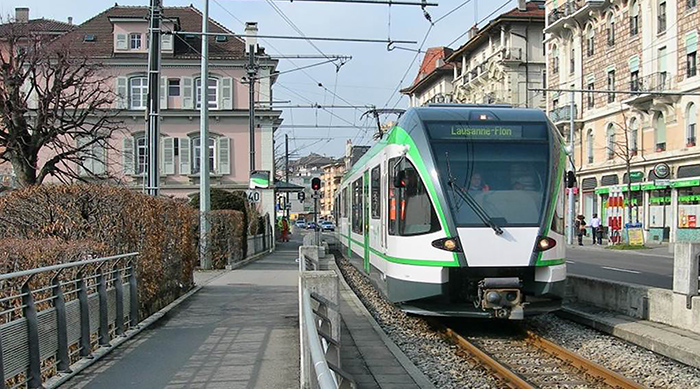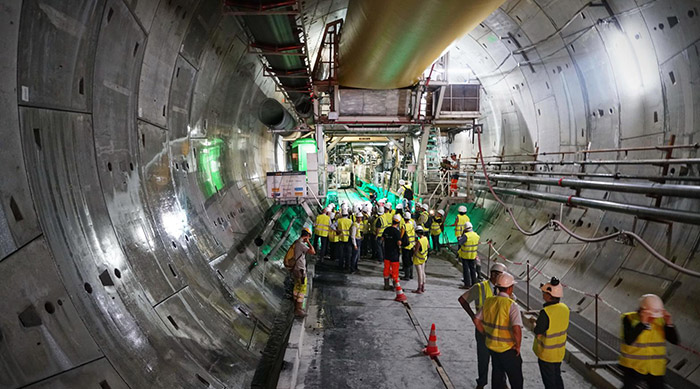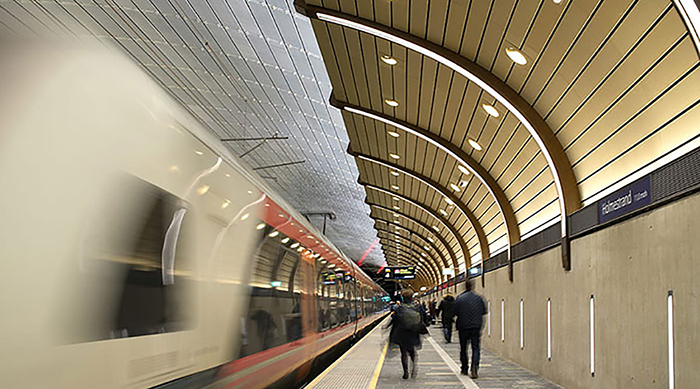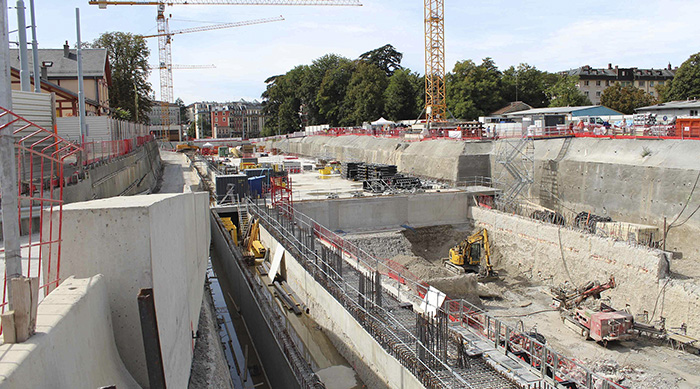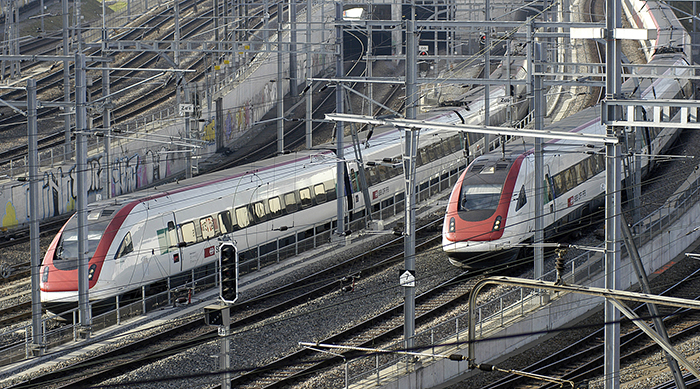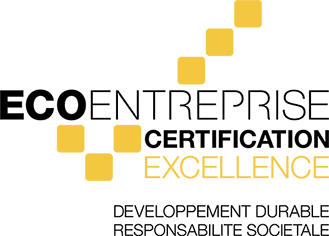VENTILATION & FLOWS
The increasing mobility of people and goods, the increase in the speed of transport and the development of more and longer tunnel sections are some of the factors pushing manufacturers and operators to continuously improve their transport infrastructure and systems. These developments entail paying particular attention to improving the safety of people and infrastructure. In fact, in tunnels, stations or other closed buildings, the different flows (aerodynamic and thermal phenomena, propagation of smoke in the event of fire, ventilation, pedestrian flow, etc.) play a decisive role, and must be taken into account from the very start when designing new transport systems or underground structures, as well as when modernising existing infrastructure.
Our team of specialists deals with all flow phenomena on a daily basis. They carry out studies and projects on aerodynamics, thermodynamics and ventilation, as well as on evacuation and managing the pedestrian flow. To do this, they rely on calculations, theoretical models, experimental measurements and digital simulations using well-known software. GESTE notably took part in the development of simulation software.
Domains of activity
- Rail, metro, road and river tunnels
- Rail and bus stations
- Depots, car parks and garages
- Underground infrastructure
- Skating rinks, stadiums, theatres and other high-capacity buildings
- Shopping centres, offices, schools, nurseries and other buildings open to the public
- Industrial buildings
- Enclosed spaces
- Conventional, self-driving or innovative vehicles
Systems and equipment
- Sanitary ventilation and firefighting equipment
- Cooling and air conditioning equipment
- Detection and measurement equipment
- Firefighting equipment
- SCADA
Services
STATION AND TUNNEL VENTILATION, SMOKE EXTRACTION, COOLING, CLIMATE, HVAC (HEATING, VENTILATION, SANITARY, ELECTRICITY)
- Engineering services for preliminary studies, tests and commissioning
- Project management, assistance with works management
- Advice, expertise, audits
PARTICIPATION IN R&D PROGRAMMES
- Modelling and developing ad hoc software, internally or as part of R&D programmes in collaboration with research centres
- Collaboration with universities and polytechnics, particularly including EPFL
- Participation in research and development programmes
DIGITAL SIMULATIONS AND TESTS
- Stationary and non-stationary digital simulations of simple and complex geometries (1D, 2D and 3D)
- CFD
- Aerodynamic, aeraulic and thermodynamic simulations
- Smoke propagation and smoke extraction simulations
- Pedestrian flow and evacuation simulations
- Fire tests (cold and hot smoke)
- Measurement of aerodynamic fields (air speed, pressure, temperature, humidity)
AERODYNAMIC, AERIAL AND THERMODYNAMIC STUDIES
- For vehicles moving in tunnels: calculation of aerodynamic forces, pressure waves, thermal fields, etc. and their impact on people and infrastructure
- Assessment of tympanic comfort and optimised ventilation of the tunnel section, anti-piston branches, ventilation shafts and other geometric choices
- Calculation of pressure loads on automatic doors, equipment and fans
- Calculation of the long-term evolution of air and rock temperature in a network of tunnels and underground stations
SMOKE PROPAGATION AND SMOKE EXTRACTION STUDIES
- Fire and smoke spread simulations, with or without ventilation equipment
- Simulation of the evacuation of people
- Simulation of the temperature evolution in infrastructures and calculation of materials' fire resistance
- Fire protection concepts
- Concepts of smoke extraction and passenger emergency evacuation, tunnel ventilation concepts
- Sizing and design of ventilation and smoke extraction systems
PEDESTRIAN FLOW AND EVACUATION OF PEOPLE
- Pedestrian flow simulations in normal operation and in case of emergency
- Simulations of the evacuation of people and analysis of pedestrian flow in complex buildings (stations, stadiums, underground spaces, etc.)
- Calculation of journey times and optimisation of infrastructure (width of passages, number and width of ramps, stairs, escalators and elevators; positioning and sizing of emergency routes and exits, etc.)
- Safety, evacuation and rescue intervention concepts
Software
SOFTWARE DEVELOPEN IN-HOUSE
GESTE a développé ses propres logiciels afin de disposer d'outils adaptés aux besoins de ses clients. Il s'agit des logiciels suivants:
- TNT (Tunnel Nets & Trains) is a 1D aerodynamic solver developed and validated by GESTE for the digital simulation of compressible and non-stationary flows induced by the movement of vehicles in confined spaces with complex geometry such as tunnels road or rail. It also simulates the propagation of smoke in the event of a tunnel fire, taking into account ventilation and moving vehicles. It additionally performs evacuation simulations.
- TunClim, fully developed and validated by GESTE, is a 2x1D thermodynamic solver for calculating long-term changes in air and rock temperature for networks of deep tunnels. TunClim integrates parameters such as air flow, air humidity, heat sources and wells, and heating/cooling systems.
- NSMB-TNT: NSMB is a compressible and non-stationary CFD software developed, among others, by various universities (EPFL in Lausanne, SERAM in Paris, IMFT in Toulouse and KTH in Stockholm), a research centre (CERFACS in Toulouse) and various industrial partners like EADS-France (Airbus France and EADS Space Technologies), SAAB Military Aircraft and CFS Engineering. As part of his doctorate at EPFL, just before creating GESTE, Michele Mossi carried out a dynamic coupling of NSMB (3D) and TNT (1D) software for a precise study of aerodynamic phenomena in long tunnels, by simulating the flow near vehicles in 3D and the distant flow in 1D. Then, as part of a research project sponsored by the Swiss Commission for Technology and Innovation (CTI), the Federal Institute of Technology in Lausanne (EPFL) and GESTE joined forces to further develop this tool and adapt it to simulate fires in long tunnels.
OTHER CFD (COMPUTATIONAL FLUID DYNAMICS) SOFTWARE USED INTERNALLY
GESTE also regularly uses commercial or open-source software. For complex, non-stationary compressible fluid dynamics problems, the following 3D digital solvers are used:
- Fire Dynamics Simulator (FDS) is a piece of fluid mechanics software dedicated specifically for air flows induced by the development of fires. It digitally solves a simplified form of the Navier-Stokes equations adapted to low-speed and thermo-controlled flows, with an emphasis on the transport of smoke and heat. The modelling approaches used take into account turbulence phenomena, combustion reactions and thermal radiation.
- PyroSim is a graphical interface for the FDS software. It makes it easier to create complex fire models (geometry, mesh, material characteristics, growth curve of thermal power, fire scenario).
- ANSYS Fluent et Simcenter STAR-CCM+ are pieces of software capable of handling complex fluid problems. Different 3D digital solvers solve the physics of non-stationary and compressible flows. Specific models are used to model turbulence, heat transfer, combustion and multi-phase flows in particular.
To simulate pedestrian flows, in addition to the model integrated in TNT, GESTE uses the following commercial software:
- SimWalk Transport is commercial software used to simulate and analyse the movements of trains and road vehicles as well as pedestrian flows; it focuses on the field of transport infrastructure. It allows the integration of parameters like timetables and agent-based microsimulation modelling (each pedestrian is thus modelled with their goals and their own behaviour). This type of modelling makes it possible to simulate, flexibly and realistically, both normal behaviour and panic situations in complex environments. GESTE typically uses SimWalk software for:
- testing the effectiveness of emergency exits from railway stations, airports and other complex buildings,
- urban planning,
- traffic engineering,
- supporting the architectural design of buildings and public spaces, validating architectural concepts,
- pedestrian simulation in architecture.
- Pathfinder is a pedestrian flow simulator. It contains a user interface to extract horizontal and vertical circulation spaces from buildings (stairs, ramps, elevators), configure the occupants' characteristics (gender, speed of movement, behaviour) and present realistic 3D animations. It is used to assess the comfort and safety of pedestrians in structures open to the public (stations, airports, shopping centres, sports arenas).
To view and analyse results, GESTE relies on the following tools:
- Tecplot 360 is technical data visualisation software, used among other things to analyse data from digital simulations of fluid mechanics problems.
- ParaView is open-source and cross-platform data analysis and visualisation software. Data can be exploited interactively in 3D or by programme using batch processing capabilities. It is a post-processing tool well suited to digitally simulating fluid mechanics problems.
- Smokeview is visualisation software used to display the results of FDS simulations.



